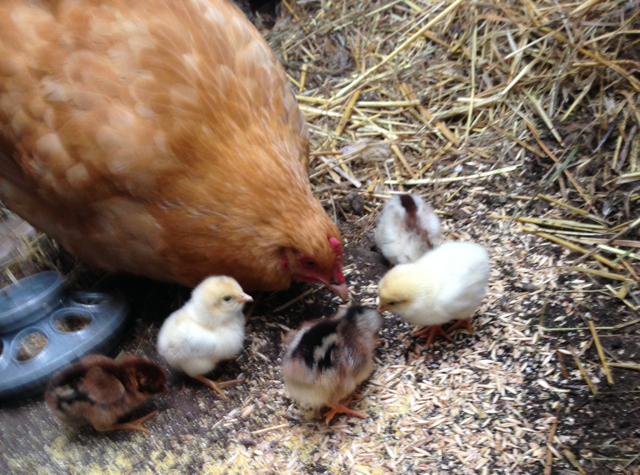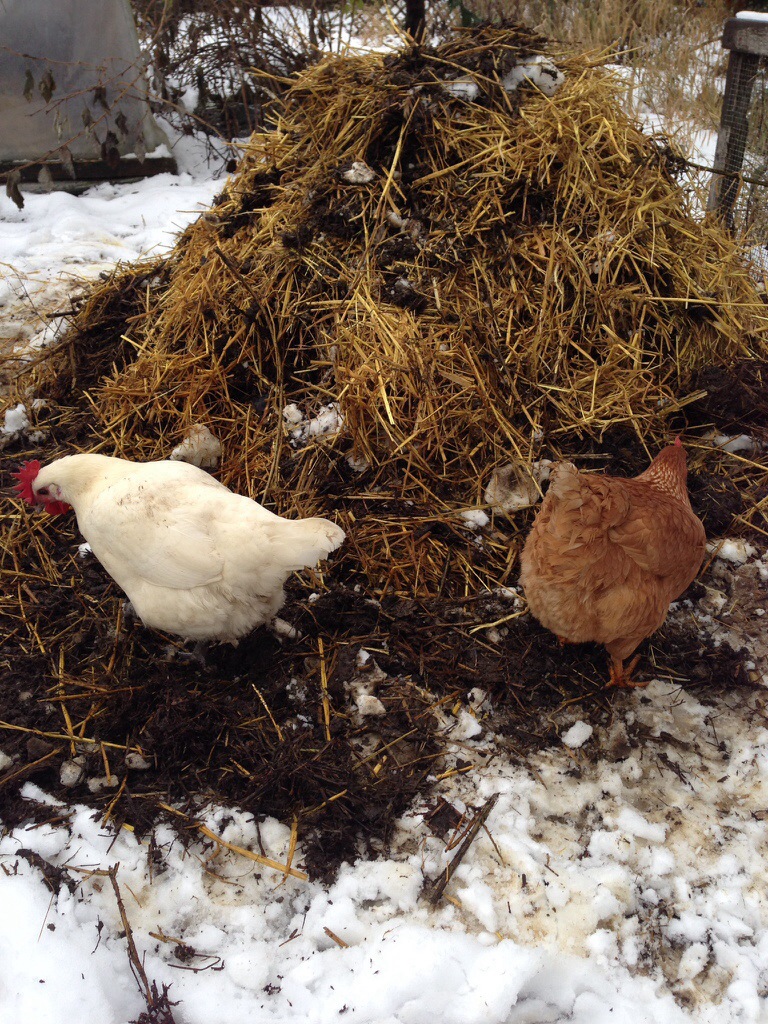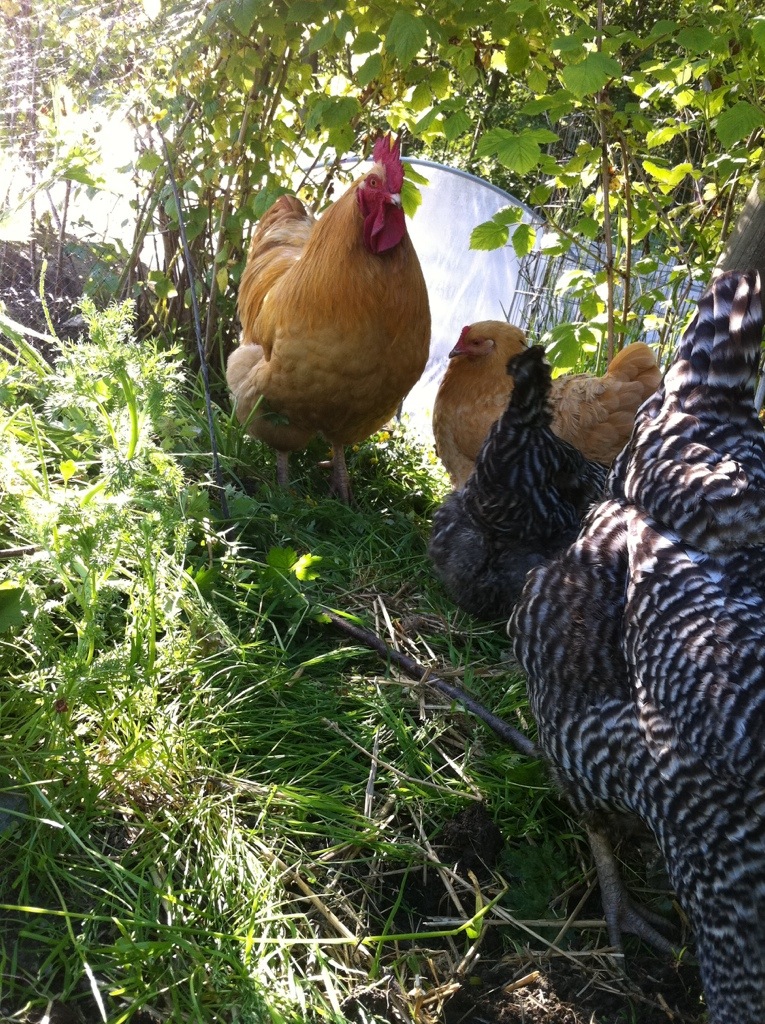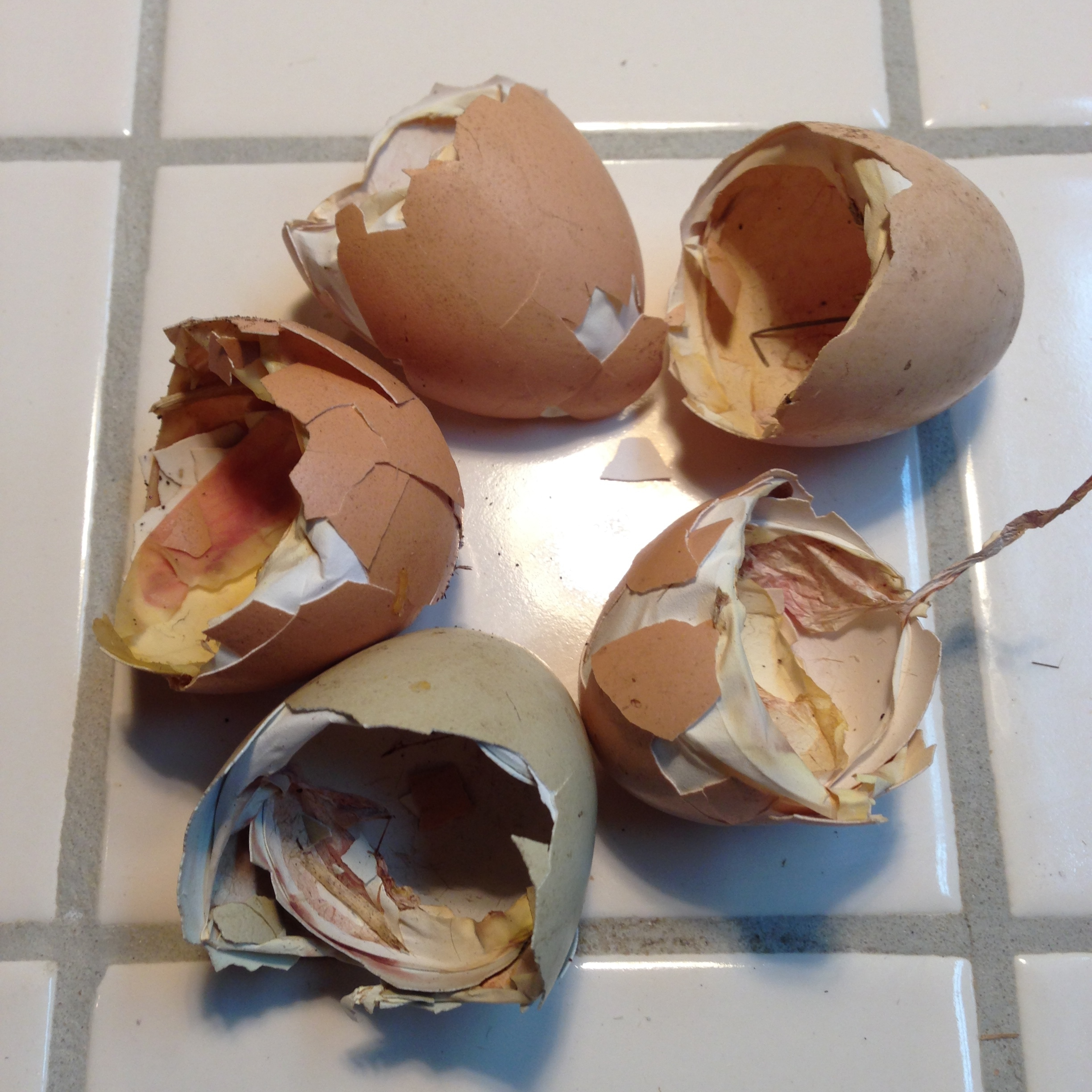
After three days, we get a good look of the new chicks. They are off to a good start and before long, the hen will be taking them outdoors to find lots of good things to eat. Life can be very good for chicks on a farm.
[wpvideo 8dfTYZIi]
every day is a good day

On a winter day when snow blankets the ground, there’s always something good to eat in the compost. When it is time to turn a compost pile I can always count on chickens rushing over to feast on worms and bugs in the pile. Chickens are far from vegetarians. Skilled hunters, it is a good thing they are small. If they towered over us we would be their dinner.

It’s day two of the chicks, but you can’t see them because mother is being very protective. Hopefully I’ll be able to get a good picture soon.

And here is one of the Turken hens. Originally from Romania, Hungary, and Transylvania, they are a curious, friendly breed. I ended up with Turkens when someone nearby unexpectedly ended up with some this summer and asked me to take them.
Earlier this year I was examining chicken at a Whole Foods store and reading about the way they grade chicken. They have 5 grades of chicken and depending on the grade they tolerate from 0.5% up to 15% of a flock to have hock burn. Hmm, I thought, what is hock burn?
I discovered that
Hock burns are marks found on the upper joints of chickens and other birds raised on broiler farms. These marks are where the ammonia from the waste of other birds has burned through the skin of the leg, leaving a mark. Many meat processors now remove these marks as they discourage customers. Hock burn normally does not surpass 15% of a flock, according to poultry industry standards, but independent studies have found incidents of hock burn more common. Researchers at the University of Cambridge found that hock burn could be identified in 82% of chickens sold in supermarkets. (Wikipedia)
I was aghast. What farmer would ever raise chickens in such dire conditions that parts of their bodies get burned because they are sitting in so much shit! How can the Department of Agriculture and the Food and Drug Administration allow chickens to be raised in such filth? And these deplorable conditions are so prevalent that even chicken sold at Whole Foods has hock-burn.

You will never find hock burn in any of my chickens. For one, my chickens are out and about all day running through grass, pasture, garden and woodland. Two, at night they sleep high above the ground on roosts. The straw and hay under their roosts is cleaned regularly. Their thighs are never in a situation where they would be sitting or standing in piles of shit. Chances are good that chicken you buy in supermarkets, even high quality ones like Whole Foods, is chicken that is wallowing in so much shit that it’s thighs are getting burned. Do you really want to buy and handle such meat?
Today Consumer Reports posted an article, The High Cost of Cheap Chicken, about the high levels of bacteria, including antibiotic-resistant bacteria, on most chicken sold in supermarkets. This isn’t surprising considering the deplorable conditions under which most chickens are raised. Also most chickens are fed feed containing antibiotics, increasing the likelihood that bacteria on these chicken farms will develop resistance to antibiotics. None of my chickens ever receive antibiotics. They forage for a large percentage of their food eating grass, bugs, earthworms, berries, and other delicious food they find. I supplement their diet with certified organic grains. According to the National Chicken Council
In practice, most chickens stay close to water and feed, which is usually located within the chicken house.
I’ve never had chickens that stay close to water and feed. Even if I dump out buckets of grain in the chicken yard, my chickens will feed on it for a few minutes and then move on to explore the brush, gardens, and woods. Perhaps the reason chickens on your typical chicken farm don’t venture far from food and water is because they don’t have acres of brush and pasture.

It means that the price of my chicken is exorbitant compared to other chicken, however you will be hard pressed to find more humanely raised and contented chicken.
[wpvideo 9ixku7Qg]
These chicks are just a few hours old. I usually do not let the hens hatch chicks this time of year, but I made an exception for this hen. For 21 days she has been incubating the eggs. Tonight, when it got dark, I moved her and her chicks to a quiet spot in a small house in the covered chicken yard so she won’t have to worry about any rain or snow. She hatched these chicks in a dog house out in the open. Tomorrow or the next day when she takes her chicks out of the house, she’ll have a private yard for her chicks, and then in a few more days, when she is ready, she will take them outdoors to explore.
If you turn the volume up, you can hear the deep, clucking sound she makes as I reach underneath her. That is the call hens make to warn their chicks that danger is nearby.

And this is what the eggs look like after they have hatched. Normally the hen or other chickens would eat these.
December isn’t the best time for hens to hatch chicks. Usually when hens go broody this time of year, I replace the eggs they are sitting on with wooden eggs. That way they will keep sitting and eventually give up trying to hatch the wooden eggs after four to six weeks. I’ve discovered that if you remove the eggs and leave the hens with nothing to incubate, they can become quite upset at losing their eggs. They go through a period where they are clearly distressed. The nearest I can describe it is that they go through a mourning period. This doesn’t happen if I let them go through a full brooding period and let them give up trying to hatch the wooden eggs.
Does it really matter taking this much care over chickens? It does to the chickens. Compared to our complicated lives, chicken lives are simpler, but they aren’t mindless creatures without feelings and desires. They are more than animal robots. Each hen has her own style of mothering. Each chick has its own personality. When you purchase one of my chickens, it has lived the most natural life a chicken possibly can.